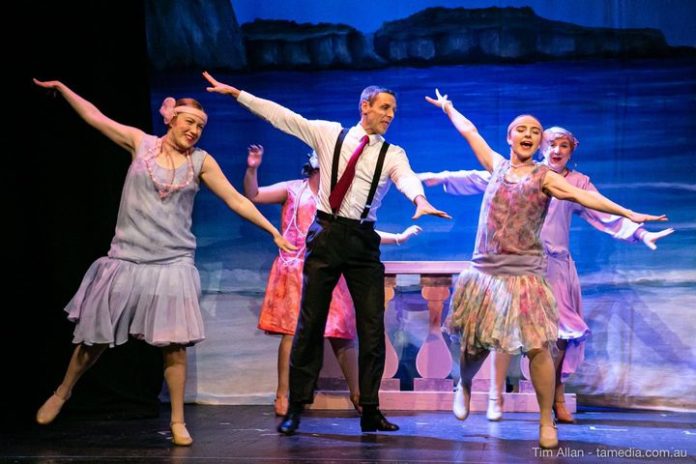The Met’s latest production – “Nice Work If You can Get It” – is a pastiche musical set in the 1920s featuring almost twenty songs and a bevy of instrumental excerpts by George and Ira Gershwin. The songs are held together by a hilariously improbable storyline written by Joe DiPietro (also known for Memphis; All Shook Up; and I Love You, You’re Perfect, Now Change). With creatives of the stature of the Gershwins and DiPietro at the heart of the show, you know you’re probably in for a good toe-tapping time, and the Met’s production does not disappoint.
The storyline follows the chaotic romantic exploits of socialite Jimmy Winter as he tries to secure a happy (and lasting) third-time-lucky marriage with someone his exceedingly wealthy mother will approve of and hence not disown him. Jimmy gets very drunk at his buck’s party – partly because he doesn’t really love his fiancé Eileen – and is subsequently taken advantage of by some bootleggers who decide to hide a large shipment of booze at his family’s rarely-used holiday mansion where the wedding will be held, but the bootleggers don’t know that! Eventually Jimmy, Eileen, their families and various guests arrive at the mansion and assume that the lead bootleggers – Cookie McGee and Billie Bendix – are the resident servants. It’s a case of mistaken identity that leads to one hilarious event after another.
Directed by Selena Britz, with competent musical direction by Jesse Budel and snappy choreography by Carmel Vistoli, the strength of this production is the uniform strength of the entire cast. Certainly there are key principals who shine in their roles – more on that later – but no-one really eclipses anyone else. Put another way, there are no weak links at all, and everyone gives their full measure (and some) to ensure the show moves along at a cracking pace and is mined for all that it can give. The script includes many very funny tongue-in-cheek one-liners that are delivered with crispness and timing, and (pleasingly) there is no gratuitous attempt to milk the audience for laughs. In particular, Barry Hill and Iman Saleh show great skill in this respect, but they are not alone.
Joel Amos, as Jimmy Winter, has a pleasing light tenor voice and is sufficiently gormless to be endearing. He is also light on his feet and his choreographed routine with Hannah Saxon (Billie Bendix) is charming and fun. Saxon plays Billie with just enough tomboyish characteristics but reveals her feminine charms when it matters. Saxon has a convincing alto/soprano voice and in the main gives an excellent account of her numerous musical numbers, especially ‘Someone To Watch Over Me’. Kristel Dally relishes in the role of Eileen and her bathroom scene and rendition of ‘Delishious’ is … well … delicious! Carolyn Adams, as Estonia Dulworth, is larger than life and makes us all exceedingly glad that we do not live in times of prohibition and temperance. She sings ‘Demon Rum’ with vitriol verily dripping from her tightly pursed lips! Ian Rigney plays Senator Max Evergreen with equal measures of pretentiousness and ridiculousness, as does Jamie Wright as Chief Berry. In the role of Millicent Winter, Kay Hamlyn gives an object lesson in how to make a small role as big as any of the others. Barbara Nutchey is compelling as the social climbing Jeannie Muldoon, and a highlight of the show is her seduction scene with Saleh whose comedic body language is beautifully crafted. And then there is the ensemble: energetic, always smiling, and enthusiastic.
Barry Hill as Cookie McGee is the clear standout. He has crafted a well thought out character replete with guile, cantankerousness, quirkiness, and child-like mischievousness – all with a glint in his eye and faultless diction (even in his brisk singing numbers). Hill plays the role in a fairly straight manner and allows the well-crafted text do much of the talking as he nudges it along without resorting to unrestrained farce. That’s experience talking!
Selena Britz and Leonie Osborn’s set design is bright, detailed (without being fussy) and captures well the essence of the art deco style of the 1920s. Carmel Vistoli and Leonie Osborn’s costuming is also a highlight. The female ensemble wore jazz era inflected dresses that invoked Coco Chanel, and they look glamorous and totally at home in them. Lighting by Clinton Camac complemented the set and costumes but might have been more dazzling in the speakeasy scenes. Jesse Budel’s orchestra was well balanced and featured mainly brass and woodwind, which suited Gershwin’s score. On a few occasions the orchestra overshadowed the singers particularly for the opening phrases of some musical numbers.
This high quality production is a success story for the Met, and the opening night audience lapped up every minute of it.



